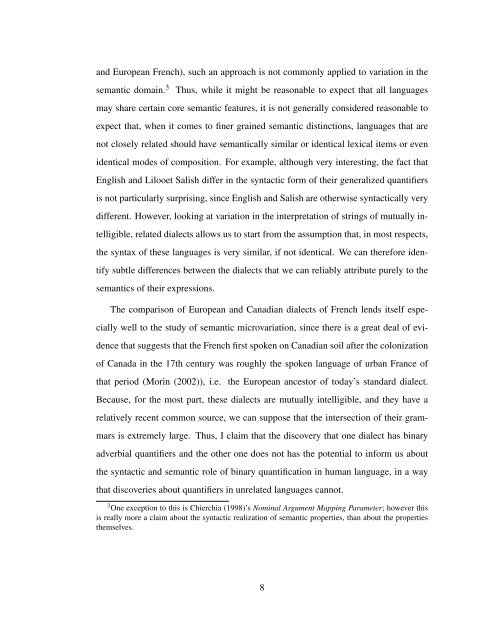Formal Approaches to Semantic Microvariation: Adverbial ...
Formal Approaches to Semantic Microvariation: Adverbial ...
Formal Approaches to Semantic Microvariation: Adverbial ...
Create successful ePaper yourself
Turn your PDF publications into a flip-book with our unique Google optimized e-Paper software.
and European French), such an approach is not commonly applied <strong>to</strong> variation in the<br />
semantic domain. 3<br />
Thus, while it might be reasonable <strong>to</strong> expect that all languages<br />
may share certain core semantic features, it is not generally considered reasonable <strong>to</strong><br />
expect that, when it comes <strong>to</strong> finer grained semantic distinctions, languages that are<br />
not closely related should have semantically similar or identical lexical items or even<br />
identical modes of composition. For example, although very interesting, the fact that<br />
English and Lilooet Salish differ in the syntactic form of their generalized quantifiers<br />
is not particularly surprising, since English and Salish are otherwise syntactically very<br />
different. However, looking at variation in the interpretation of strings of mutually intelligible,<br />
related dialects allows us <strong>to</strong> start from the assumption that, in most respects,<br />
the syntax of these languages is very similar, if not identical. We can therefore identify<br />
subtle differences between the dialects that we can reliably attribute purely <strong>to</strong> the<br />
semantics of their expressions.<br />
The comparison of European and Canadian dialects of French lends itself especially<br />
well <strong>to</strong> the study of semantic microvariation, since there is a great deal of evidence<br />
that suggests that the French first spoken on Canadian soil after the colonization<br />
of Canada in the 17th century was roughly the spoken language of urban France of<br />
that period (Morin (2002)), i.e. the European ances<strong>to</strong>r of <strong>to</strong>day’s standard dialect.<br />
Because, for the most part, these dialects are mutually intelligible, and they have a<br />
relatively recent common source, we can suppose that the intersection of their grammars<br />
is extremely large. Thus, I claim that the discovery that one dialect has binary<br />
adverbial quantifiers and the other one does not has the potential <strong>to</strong> inform us about<br />
the syntactic and semantic role of binary quantification in human language, in a way<br />
that discoveries about quantifiers in unrelated languages cannot.<br />
3 One exception <strong>to</strong> this is Chierchia (1998)’s Nominal Argument Mapping Parameter; however this<br />
is really more a claim about the syntactic realization of semantic properties, than about the properties<br />
themselves.<br />
8
















